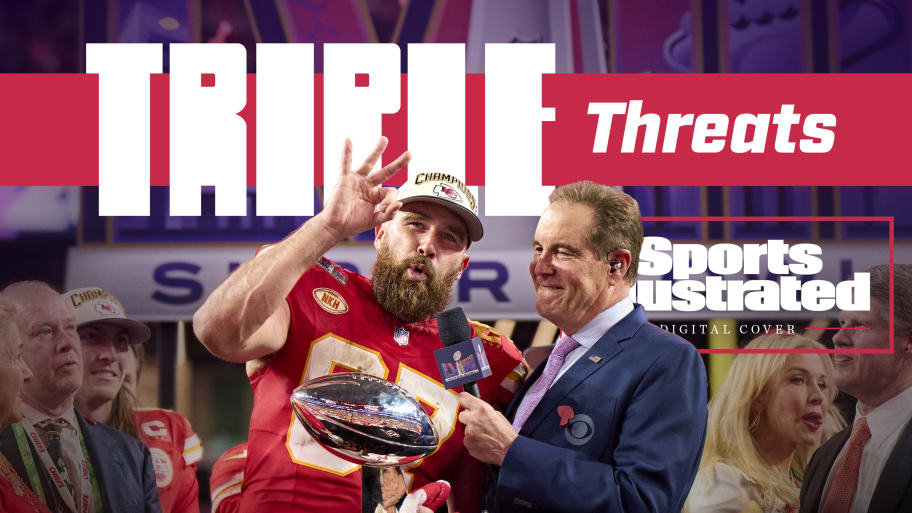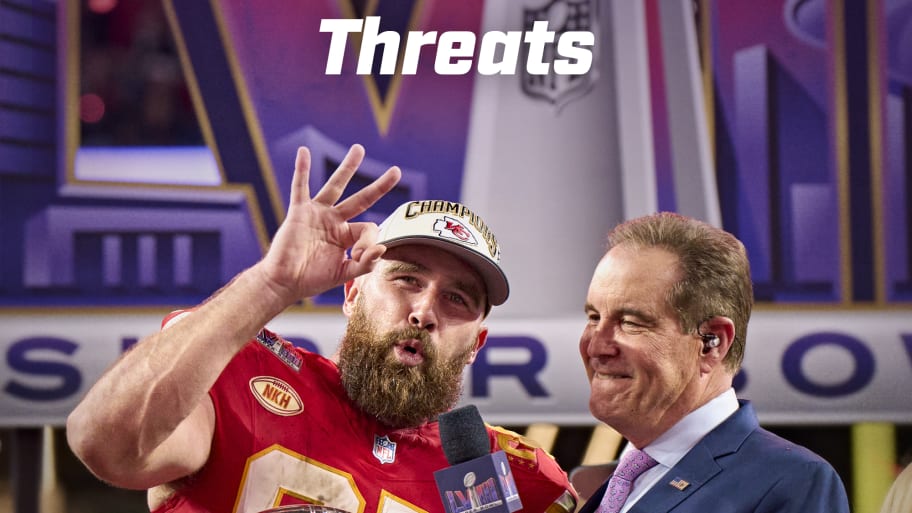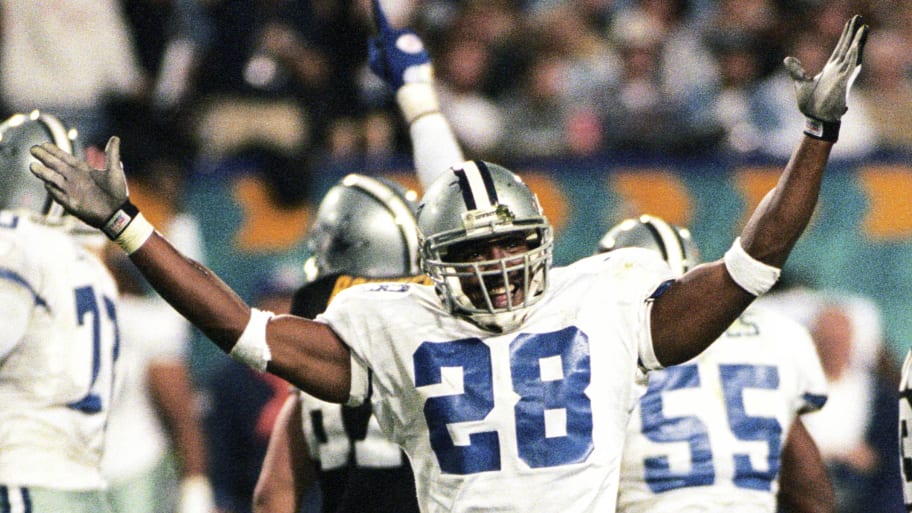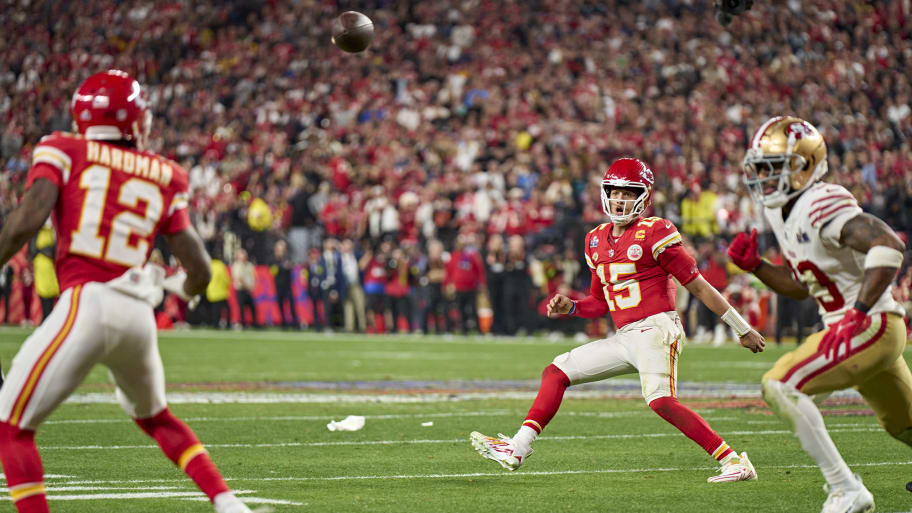
Darren Woodson can still hear Michael Irvin. We have to three-peat. In January 1994, the Cowboys had just won their second consecutive Super Bowl, again defeating the Bills. Afterward, a group of large, tired men were waiting to get onto their bus outside the Georgia Dome, ready to depart for the airport. At that moment, Irvin, the future Hall of Fame receiver, announced there would be no rest. Dallas was going to commit to doing something no team had ever done: win three straight Super Bowls.
“It was a goal,” Woodson says. “Mentally, we had just got done playing these long-ass seasons, but I wanted to be the first [to three-peat]. If you have guys with that kind of mindset, that want to make history ... Patrick Mahomes, knowing how competitive he is, he’s not going to rest and just say, ‘I’m happy with two. I’m just going to take this season and it’s O.K.’ No. No, there is no O.K.”
“It was a goal. Mentally, we had just got done playing these long-ass seasons, but I wanted to be the first [to three-peat]. If you have guys with that kind of mindset, that want to make history ... Patrick Mahomes, knowing how competitive he is, he’s not going to rest and just say, ‘I’m happy with two. I’m just going to take this season and it’s O.K.’ No. No, there is no O.K.”Darren Woodson
But Dallas’s three-peat bid came to an end in the NFC championship game in January 1995, when the Cowboys fell to the 49ers at Candlestick Park. It was a mixture of many things, none bigger than losing coach Jimmy Johnson in a power struggle with owner Jerry Jones before the season. But ultimately, Dallas couldn’t overcome injuries. It couldn’t overcome ego. It couldn’t overcome attrition.
It simply couldn’t overcome.
This season, the Chiefs are aiming to do what the Cowboys and seven other teams couldn’t: hoist a third straight Lombardi Trophy. Already, Kansas City is a dynasty, having won three times in the past five seasons. The Chiefs are the first repeat champion since the 2003–04 Patriots. But to be the first to three-peat in the Super Bowl era, they must avoid the bad fortune and missteps others haven’t been able to navigate.

“I think they can do it given their talent and the exposure they’ve had in the past,” says Steelers fullback Rocky Bleier, who had two chances to three-peat, in 1976 (when Pittsburgh lost the AFC championship to the Oakland Raiders) and 1980 (9–7, missed the playoffs). “But every team they play, it’s going to be their Super Bowl. In 17 games, every opponent wants to kick your ass. They want to beat the s--- out of you because you’re the Super Bowl champion and now you’re going for three in a row. We’re not going to allow that to happen. You’ve got to fight that.
“It’s not that everyone thinks, We’re going to give up because it’s the Kansas City Chiefs. You find those opponents play their best games, usually, against the defending champion. To [face] that week after week after week, and then avoid injuries, especially at the end of the season, when it’s needed to compete on that level—it’s always difficult.”
Of the eight NFL teams in the Super Bowl era that have attempted to three-peat, five made the playoffs. Three went on to their respective conference title games, but none advanced beyond that point. For some, the failure to win it all again was for an obvious reason.
The 1968 Packers (who did win three straight NFL championships, but their first predated the first Super Bowl) were without Hall of Fame coach Vince Lombardi, who moved to the front office full-time after Super Bowl II. “If Lombardi had known how big the Super Bowl was going to be, he would have stayed around,” says Hall of Fame linebacker Dave Robinson. “I think we could have won Super Bowl III, too. To him, winning three NFL championships [in a row] was his goal from the very beginning.”
It wasn’t easy. In 1967, the Packers had begun to fade. They went 9-4-1 and needed a last-minute comeback to defeat Dallas in the Ice Bowl before taking down Oakland in Super Bowl II. The triumph was glorious, but the season was hell.
“I remember that the older players, guys who had been around, were worn out,” Robinson says. “They had listened to Vince spread his stuff for six, seven years and it didn’t have the same impact on them. I saw guys do things that they had never done before. But we still managed to survive. When we had our backs to the wall, everyone rose to the occasion.”
For other players trying to three-peat, the issue was an unwinnable battle with their bodies. In 1976, Pittsburgh was making its first of two runs at a trifecta. Loaded with young talent and championship experience, the Steelers came into that season with major expectations. Instead, they began the year 1–4, a tough stretch that culminated with quarterback Terry Bradshaw suffering a neck injury thanks to a pile driver by Browns defensive end Turkey Jones. The Steelers rallied on the back of perhaps the greatest defense ever, winning their last nine regular season games—a stretch during which they gave up just 28 points and one touchdown—to reach the playoffs. In the postseason, Pittsburgh crushed the Colts, 40–14, but lost Bleier and backfield mate Franco Harris (both 1,000-yard rushers) to injury. The Steelers fell the next week to the Raiders.
Joe Greene remembers the season well. The 10-time Pro Bowl defensive tackle still laments those injuries, especially Harris’s, which came in the second half with the game largely already decided. Yet Greene believes the Chiefs are built in the same way that Pittsburgh was as it sought a third consecutive ring: with impeccable drafting constantly supplementing Hall of Fame talent.
“Looking at the Chiefs, they’ve replenished,” Greene says. “They’ve turned over the offensive line, they’ve turned over a little bit with the backs and the receivers. I don’t think you can say they got better losing that little wide receiver [Tyreek Hill], but they got better on defense and in the secondary.” And then there’s Mahomes. “I would say with that quarterback Kansas City has, anybody that lines up against those guys starts behind 10, because [Mahomes is] a big, big difference maker. I don’t care who the other quarterback is, [he’s] special.”

The 1994 Cowboys dealt with problems similar to those faced by the ’76 Steelers. The talent was undeniable, but so was the physical toll of playing extra games, all against the league’s best teams.
“I can’t tell you how many surgeries we had [before going] for the third one,” Woodson says. “Guys didn’t want to get fixed after the first one. I had a wrist issue and I was like, I’m not going to get it fixed going into the second year. Then the third year I had no choice. I’ve got to get this damn thing fixed.”
Had those Cowboys beaten the Niners in the NFC title game, Woodson wouldn’t have been able to play in the Super Bowl XXIX, as he required immediate back surgery. Larry Allen, the Hall of Fame guard, consistently played that year on a high ankle sprain.
In the history of three-peat attempts, perhaps the best team to ever take on the challenge was the 1990 49ers. San Francisco breezed to its second straight title in 1989, going 14–2 and winning its three playoff games by a combined score of 126–26. The following year, the Niners started 10–0 with a roster featuring seven All-Pros, including MVP quarterback Joe Montana.
“We decided to take it on and talk about it, from minicamp on through the season,” 49ers tight end Brent Jones says. “I think it just being out there, having it be a goal, talking about it, was freeing for us. It wasn’t the white elephant in the room nobody wanted to talk about.”
In the postseason, top-seeded San Francisco hosted the New York Giants in the conference championship as eight-point favorites. With less than 10 minutes remaining, leading 13–12, Montana was knocked out.
Despite the injury, the 49ers were well-positioned to kill the clock until running back Roger Craig lost a fumble with 2:36 remaining on the edge of field-goal range. New York won, and Montana never started another game for San Francisco.
Suddenly, a three-peat quest and a dynasty went from inevitable to over.
“After having won two in a row and waltzed through the league that third year, I was convinced I was packing my bags for [Super Bowl XXV],” Jones says. “It never crossed my mind, despite how tight that game was with the Giants, that we weren’t winning and going to our third Super Bowl. I don’t know that I’ve had a worse feeling in my life.”
Across the four pro sports leagues, the three-peat has been a rarity since 1980. In that period, only the Islanders have won three straight in the NHL. In baseball, the 1998–2000 Yankees are the only group to accomplish the feat. In the NBA, the Bulls did it twice with Michael Jordan (1991–93 and 1996–98), while the Lakers made history from 2000–02. So how does a modern team do something not seen in the NFL, NBA, MLB or NHL in more than 20 years? Bill Cartwright has a few thoughts.
Cartwright joined Chicago in June 1988 after a trade with the Knicks and was a starter for the Bulls’ first three-peat. While Jordan and fellow Hall of Famer Scottie Pippen were the headliners, Cartwright points to depth, continuity and timing. “If you look at our team, we had 10 guys who made a contribution, besides the fact that we had the best player in the league,” Cartwright says. “In a lot of situations, when our starters went out, our bench could not only maintain the lead but extend it. We just had really good players playing at their best at the right time.”
Of course, continuity and depth are tougher than ever to come by. MLB has a luxury tax. The other three sports all have salary caps, hard ones in the NFL and NHL. The result has been teams having to make decisions about who can stay around based not only on talent and fit, but also affordability. While free agency and the cap existed for the 1990s Bulls, player movement was far rarer in that era, with superstars such as John Stockton, Reggie Miller, Patrick Ewing, Karl Malone, Hakeem Olajuwon and others playing either their entire careers, or the vast majority of them, in one place.
“We had the same front office, the same coaching staff, we had the same core group of guys and also had our second group of starters,” Cartwright says. “In this day and age, that doesn’t happen. Guys will leave for a dollar. Guys will win a championship and then leave, which for guys in our era, is preposterous. But they will. I think it’s really hard to keep all those factors together.”

On Sept. 5, the Chiefs will host the Ravens to kick off the NFL’s 2024 season. They’ll drop another banner, and the talk will turn to making history. And with that conversation, the question will arise from fans and pundits alike. Can K.C. do it? Will the common pitfalls—injuries, ego, money and bad fortune—take down another three-peat attempt?
“I think [focus] would be the biggest challenge for the Chiefs,” Jones says. “The more success you have, the more distractions there are.”
Greene agrees.
“The Chiefs have a better chance than most teams have of winning it again,” he says. “They probably will.”
The smart money says the Chiefs will do it. Then again, in the long run the smart money is best spent betting against a team winning three in a row.
On the field of Allegiant Stadium, with confetti falling down all around them in the immediate aftermath of winning Super Bowl LVIII, Mahomes, Chris Jones and Travis Kelce were jubilant. The trio had spearheaded talk of a dynasty. But the conversations weren’t about what had been done, but what remained. They needed to win next year. They needed to three-peat.
For the Chiefs, even waiting until the bus for the airport was too long to delay their dream.
This article was originally published on www.si.com as Chiefs’ Three-Peat Bid: Why History Is Not on Their Side.







